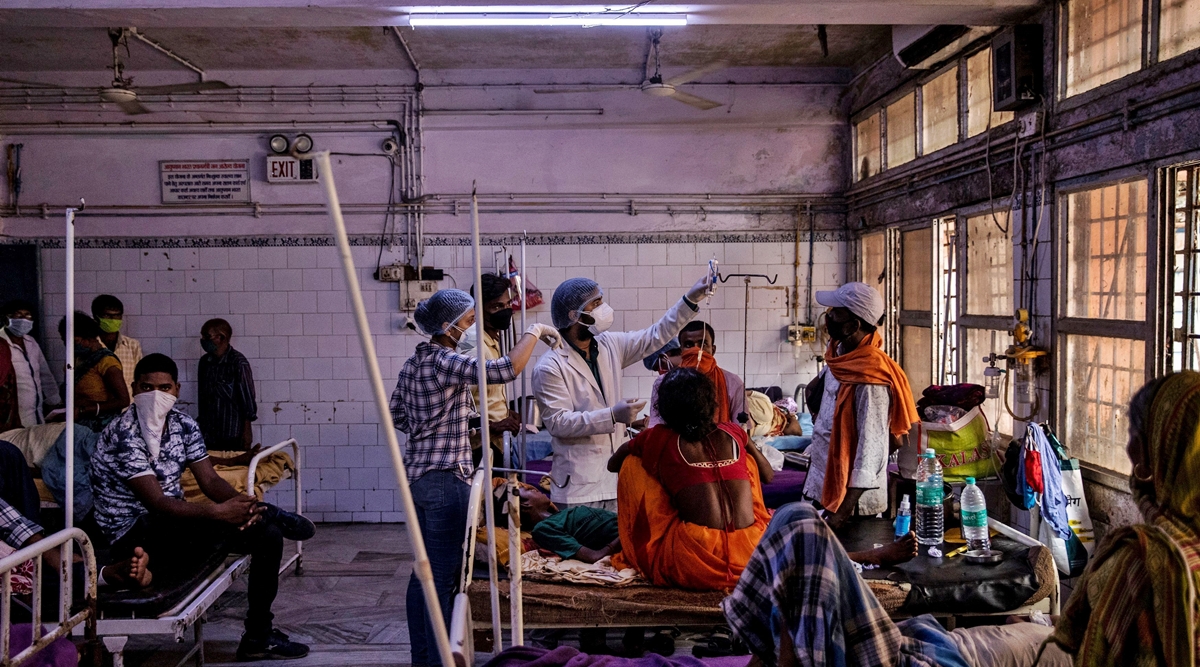COVID-19 has laid bare the state’s weak public health system, systemic flaws, structural deficiencies and gaps in implementing welfare measures
Written by Pia Sen
Nitish Kumar has been reelected Bihar’s chief minister for a fourth consecutive term. Among other things he has promised people is that his government would ramp up the health infrastructure in rural areas. This was stated in his Saat Nischay — his 2020 election manifesto. With the pandemic showing no sign of abating, improving public health facilities should be his top priority.
As per the NITI Aayog’s estimates, between 2017-18 and 2019-20, Bihar’s rank in health (SDG 3, good health and well-being) fell from 22 to 25 among 28 Indian states. The state’s performance in achieving zero hunger is also poor — on SDG 2 or Zero Hunger, Bihar ranks 26 out of 28 states. Clearly, Bihar is one of the poorest performers in India, especially in healthcare, food and nutrition security.
The deep structural deficits, systemic flaws, and gaps in implementation became evident when Bihar’s public health care system was put to test by the COVID-19 pandemic. The state, as did the country, went into a complete lockdown on March 24. The primary health and nutrition services almost ceased to function. Anganwadi centres were closed and health camps stopped. Though the sub-health centres (the first point of contact for primary health care in rural India) remained open, there was no outreach service.
A rapid survey in 18 districts of Bihar to assess the availability of basic health and nutrition services during the lockdown period by the National Coalition of Civil Society Organisations threw up some startling numbers. It was found that 16 children, under five years, died in the two months of lockdown. Health-workers said severe malnutrition was the cause of death in two cases — the children could not be referred to Nutrition Rehabilitation Centre (NRC) due to the lockdown.
In terms of nutrition security, the rapid survey found that over 60 per cent children (aged 3-6 years) did not receive regular food ration from the anganwadi centres during the lockdown. While the centres were ordered to be closed, directives were issued to distribute dry food rations to families with children, pregnant and lactating women. However, a quick assessment of the regularity of Take Home Ration (THR)/cooked food/dry food ration services from anganwadi centres during the months of April and May, 2020, found that 52.7 per cent of children aged 7-36 months and 61.7 per cent of children (3-6 years) did not receive THR. Nearly 72 per cent children did not even receive milk powder, as was promised, during this period. Out of the 90 families interviewed, 55 percent reported to be facing shortage of milk for their children during the same period.
The two main reasons cited by the anganwadi workers for not being able to provide THR/cooked food/dry food ration to children and women were lack of supply of food grains from the government (41 per cent) and constraints due to lockdown (59 per cent). For a state like Bihar, which tops the charts for child malnutrition, the survey indicates how much worse the numbers are going to be due to the closure of primary health and nutrition services.
Further, of the 222 deliveries that took place in April and May, there were three maternal deaths and two neonatal deaths. Interviews with ANM workers (Auxiliary Nurse/Midwife) revealed that these deaths did not happen due to COVID-19. Instead, the dead were victims of an inefficient healthcare system which was further crippled due to the lockdown and subsequent closure of its primary outreach services.
While the whole country went into lockdown, ASHA (Accredited Social Health Activists) and ANM workers, who are the frontline health workers, braved the pandemic and continued reaching out to people for testing, apart from their regular duties of maternal and child care. And they did all of it without receiving the basic safety gear required for safeguarding against the pandemic. Of the 67 numbers of ASHAs interviewed, only 13.4 per cent and of the 65 ANMs interviewed, only 32.3 per cent received the complete PPE kit set (gloves, mask, bodysuit and sanitiser). This rendered them to fight a battle without necessary resources leaving them vulnerable to the threats of the virus.
The pandemic laid bare a very weak public health system and the decision to shut down primary health and nutrition services facilities worsened the dire situation the poorest were already reeling under. While the decision may have reduced deaths due to COVID-19, it has exposed people to a situation where they have no place to go for basic healthcare services or availing food and nutrition security.
Expansion of health infrastructure is one of the primary agendas for the Nitish Kumar government and unquestionably the need of the hour. What is also imperative is an internal audit to assess why children were deprived of their rightful entitlements of food rations during lockdown despite government orders. There is a need to re-haul the system to make it more people-centric. Focussing on expansion of services without giving due emphasis to these issues will defeat the purpose.
The writer is programme coordinator (monitoring, evaluation, learning & MIS) with the social inclusion team at Oxfam India
Source: Read Full Article


